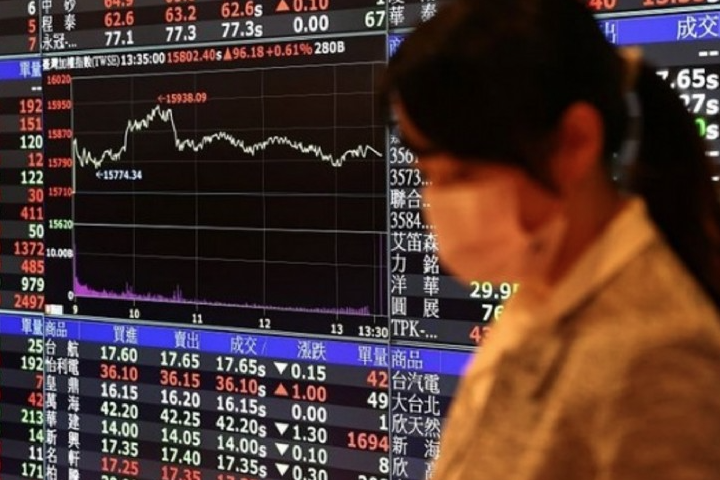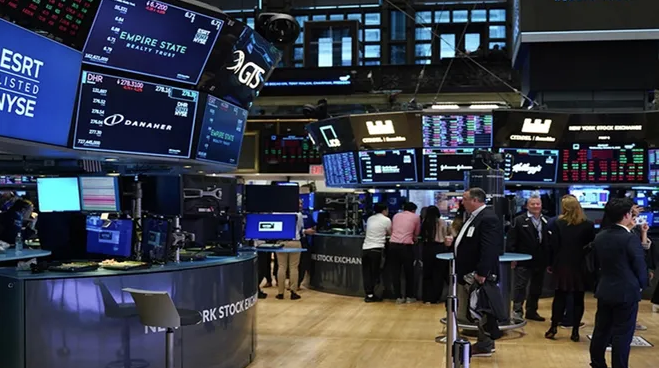Strong expectations of a “soft landing” in the US economy are dampening the effects of the continued postponement of the date of the Fed’s first interest rate cut in the money markets – In money markets, pricing that the Fed would start cutting interest rates in March with an 85 percent probability at the beginning of the year decreased to 10 percent as of the close of last week – All economists participating in AA Finans’s expectations survey expect the CBRT to leave the policy rate unchanged on Thursday.
In global equity markets, inflation data in the US exceeded expectations, making pricing difficult, while increased volatility in technology companies was noteworthy throughout the week.
Signals from macroeconomic data released in the US seem to leave investors with a period in which the US Federal Reserve (Fed) will start cutting policy rates later than expected, but strong economic activity could support corporate profitability.
Expectations of a “soft landing” for the country’s economy remain strong, which is dampening the impact on money markets as the date for the Fed’s first interest rate cut continues to be postponed.
While new product introductions in the field of artificial intelligence and studies in this field make company valuations difficult, increasing volatility in the share prices of technology companies, the cautious positive perception in the markets affects the indices in the US and Japan to hover near record highs.
In the US, according to macroeconomic data released last week, the Consumer Price Index (CPI) exceeded expectations with an annual increase of 3.1 percent in January and the Producer Price Index (PPI) increased by 0.9 percent in the same period. In this period, PPI recorded the highest monthly increase in the last five months.
In the money markets, the pricing in the beginning of the year that the Fed would start cutting interest rates in March with an 85 percent probability dropped to 10 percent as of the close of last week. The probability of the bank’s first rate cut at the June meeting is priced at 75 percent.
Analysts emphasized that the continued strong stance in US inflation increased uncertainties about when the Fed will start cutting interest rates, and said that clues about the steps to be taken in the coming period will be sought in the minutes of the bank’s meeting to be announced next week.
Verbal guidance from Fed officials was also monitored last week, with Atlanta Fed President Raphael Bostic stating that he supports the start of rate cuts this summer, but that more favorable inflation data may allow for an earlier start date.
San Francisco Fed President Mary Daly noted that 3 rate cuts this year is a “reasonable” expectation. Daly stated that they will avoid acting quickly by being patient if necessary, and that they will be ready to react quickly as the economy develops.
Richmond Fed President Thomas Barkin emphasized that the latest inflation data showed the importance of why they want to see more data before they start cutting interest rates.
Last week, the Fed released its 2024 stress test scenarios, which will help ensure that banks can lend to households and businesses even in a severe recession.
In the statement made by the bank, it was informed that 32 banks will be subjected to stress tests this year, and these banks will be tested against a serious global recession with increasing stress in commercial and residential real estate markets as well as corporate debt markets.
In this year’s scenario, the US unemployment rate rose by 6.5 percentage points to a peak of 10 percent, accompanied by severe market volatility, widening corporate bond spreads, and a “collapse” in asset prices, including a 36 percent drop in housing prices and a 40 percent drop in commercial real estate prices.
The dollar index tested its highest level in 3 years
It was noteworthy that the dollar index carried its upward trend to the seventh consecutive week. This week, the dollar index, which tested the highest level of nearly 3 months by rising to 105, closed the week at 104.3 with an increase of 0.2 percent.
While the sales-weighted course continued in bond markets after inflation data exceeded expectations, the US 10-year bond yield closed the week at 4.29 percent with an increase of about 12 basis points.
The ounce price of gold, which carried the downward trend to the second consecutive week as the strong dollar index and high bond yields increased the alternative cost of gold, completed the week at $ 2,12, down 0.6 percent.
Increasing tension in the Middle East due to the Israeli-Palestinian conflict continues to have an impact on oil prices. The price of Brent oil rose to 82.8 dollars a barrel last week with a 1.4 percent gain in value.
New York Stock Exchange indices pause record march
During the ongoing balance sheet season in the US, corporate profits that exceeded forecasts throughout the week helped equity markets test new highs, while the inflation data released last week in the country exceeded expectations, dampening risk appetite.
The news flow regarding technology companies operating in the field of artificial intelligence around the world also remains at the center of the agenda.
US chipmaker Nvidia, which has been at the focal point of the markets throughout the week, surpassed the market value of Google’s parent Alphabet yesterday, while the volatility in the company’s share price attracted attention with the revision of the valuations of the US information technology company Super Micro Computer.
The share price of Super Micro Computer, which gained 46 percent in the last week, completed the week with an increase of 8.5 percent with yesterday’s profit sales, while it has increased by about 175 percent since the beginning of the year.
On the other hand, AI companies continue to introduce new features of apps, helping to keep investors’ focus on tech companies.
US technology company Microsoft is reportedly planning to invest 3.2 billion euros in Germany over the next two years, mostly in artificial intelligence, while San Francisco-based technology company OpenAl last week introduced Sora, an artificial intelligence model that can create realistic and creative scenes with text commands.
On the macroeconomic data side, the consumer confidence index measured by the University of Michigan in the US also remained below market expectations despite rising to 79.6 in February.
The number of new houses started to be built in the country decreased by 14.8 percent in January to 1 million 331 thousand, the biggest decline since April 2020.
While industrial production in the US declined by 0.1 percent on a monthly basis in January, contrary to forecasts, the manufacturing index announced by the Fed’s New York branch showed a contraction in the manufacturing sector, although it was realized above expectations with minus 2.4 in February.
Following these developments, the Nasdaq index decreased by 1.34 percent, the S&P 500 index by 0.42 percent and the Dow Jones index by 0.11 percent on the New York stock exchange.
In the week starting on February 19, markets will be closed on Monday due to the holiday. Fed meeting minutes on Wednesday, weekly jobless claims, existing home sales and preliminary Purchasing Managers’ Index (PMI) data will be followed on Thursday.
Positive trend was prominent in European stock markets
While a positive trend prevailed in European stock markets last week, European Central Bank (ECB) President Christine Lagarde said yesterday that inflation in the Eurozone has receded towards the target, but they need more data to make sure that the 2 percent target is achieved.
Analysts stated that pricing that the ECB could start interest rate cuts in June remains strong, and that signs of the steps it will take in the coming period will be sought in the minutes of the bank’s last meeting, which will be announced next week.
The European Union (EU) Commission lowered its forecast for economic growth in the Eurozone this year from 1.2 percent to 0.8 percent as purchasing power weakened and high interest rates reduced lending.
While the data released across the region last week continued to give mixed signals, the British economy shrank by 0.3 percent in the October-December period last year, above expectations, and contracted for the last two quarters and entered a technical recession.
In the country, CPI decreased by 0.6 percent on a monthly basis in January, more than expected, while it increased by 4 percent on an annual basis, in line with forecasts.
It was noteworthy that industrial production in the Eurozone exceeded expectations with an increase of 2.6 percent in December last year compared to November.
The euro / dollar parity, which fell to 1.0700 during the week and tested the lowest level of the last 3 months, completed the week at 1.0780 with a 0.1 percent decrease.
Last week, the FTSE 100 index in the UK gained 1.84 percent, the DAX index in Germany 1.13 percent, the CAC 40 index in France 1.58 percent and the MIB 30 index in Italy 1.84 percent.
Next week, ECB meeting minutes will be followed on Wednesday, leading PMI and inflation data in the Eurozone on Thursday and growth data in Germany on Friday.
Positive trend also prevailed in Asia
While Asian equity markets were heavily bid last week, Chinese equity markets did not trade throughout the week due to the New Year holiday.
While it is noteworthy that the Nikkei 225 index in Japan is close to the peak of the last 34 years, the 5 percent appreciation of the share price of Softbank, one of the country’s largest companies, was also effective in the rise in question.
Analysts stated that the company’s shareholding in chip designer Arm Holdings played an important role in the rise in Softbank, and that the statements of the Bank of Japan (BoJ) officials that they are in no hurry to raise interest rates also supported the risk appetite in the region.
BoJ Governor Kazuo Ueda said during the week that the tight stance in the labor market continues and that companies think that rising costs may be reflected in price increases.
On the other hand, according to the data announced in the country, GDP declined by 0.1 percent in the 4th quarter compared to the previous quarter, falling below expectations. Forecasts were that the Japanese economy would grow by 0.2 percent in the relevant period.
The dollar/yen parity, which carried the upward trend to the third consecutive week, completed last week at 150.2 with an increase of 0.6 percent and realized the highest weekly closing in the last three months.
Following these developments, the Nikkei 225 index in Japan gained 4.31 percent, the Hang Seng index in Hong Kong gained 3.77 percent and the Kospi index in South Korea gained 1.10 percent on a weekly basis.
In the week starting February 19, investors will focus on machinery orders in Japan on Monday, the interest rate decision of the People’s Bank of China (PBoC) on Tuesday, the foreign trade surplus in Japan on Wednesday and the leading PMI data in Japan on Thursday.





